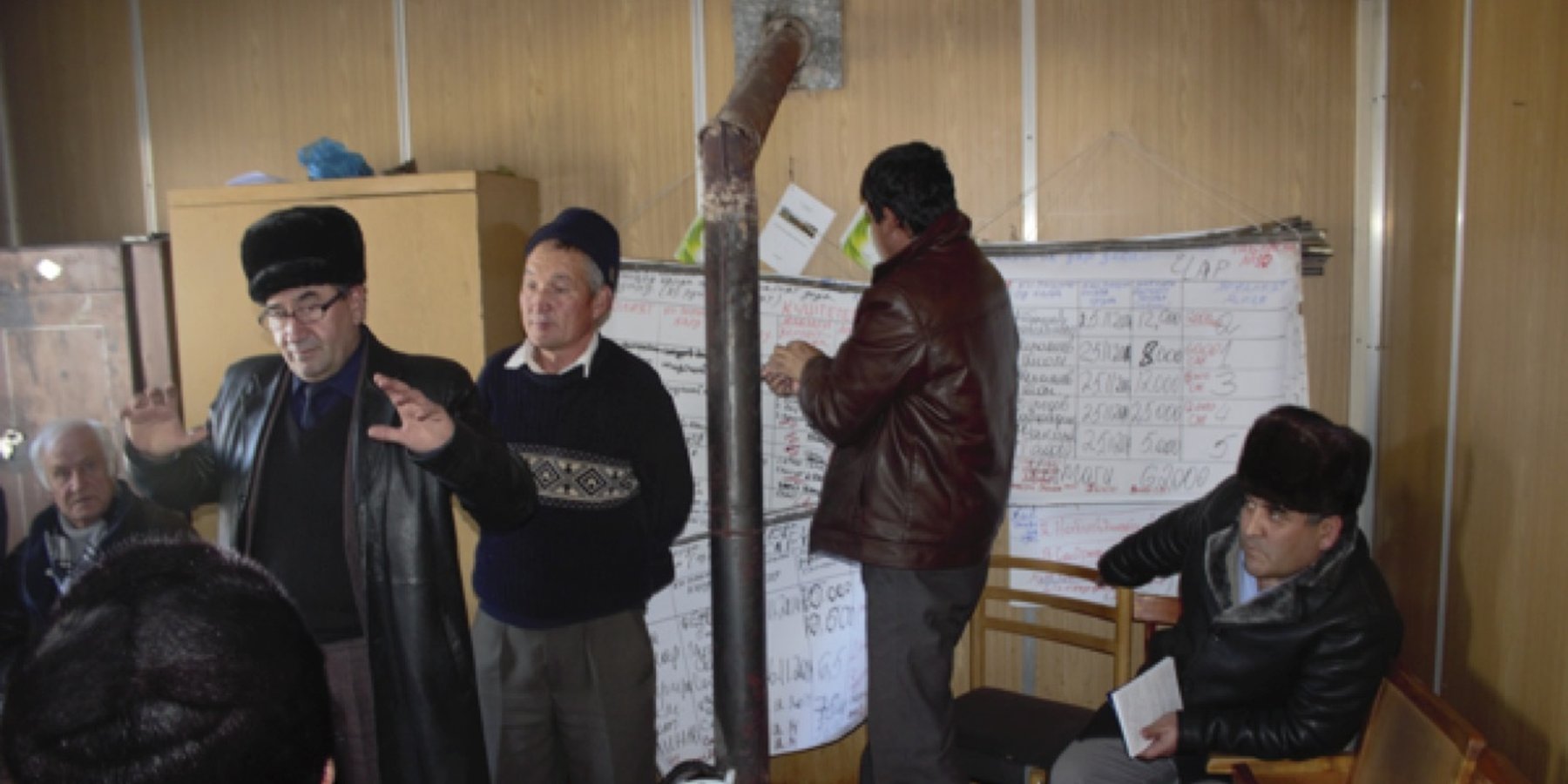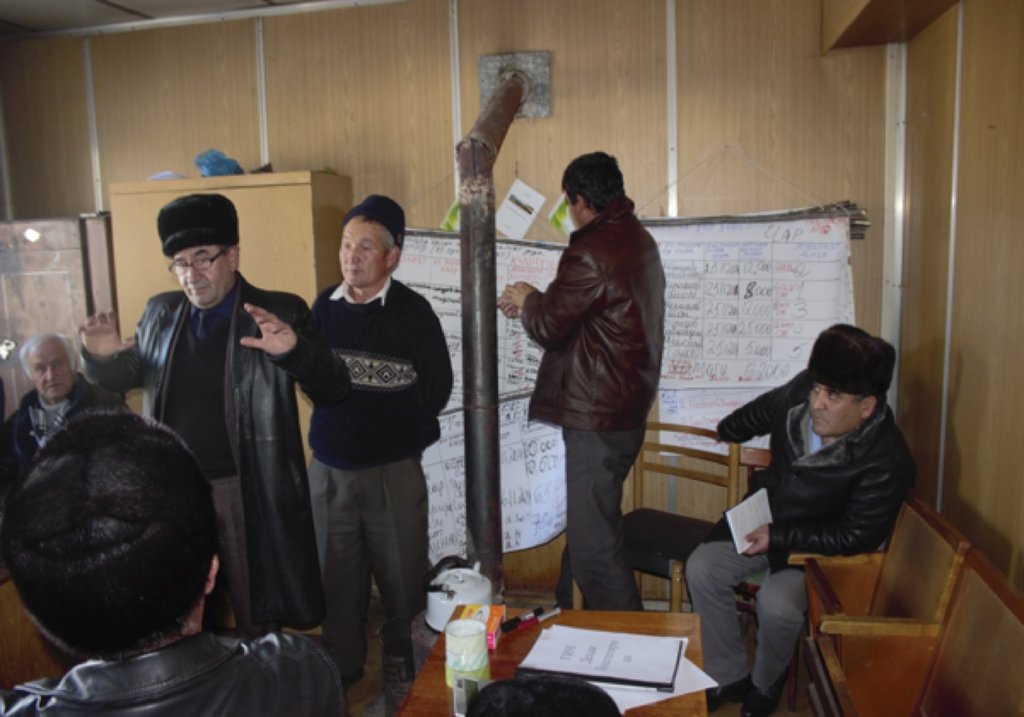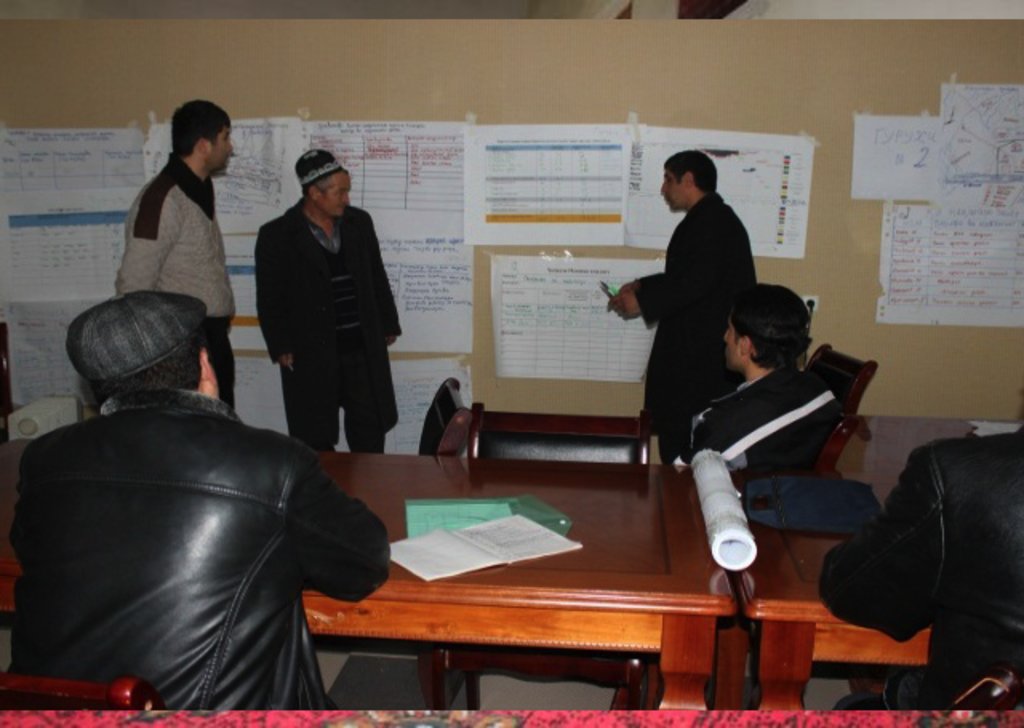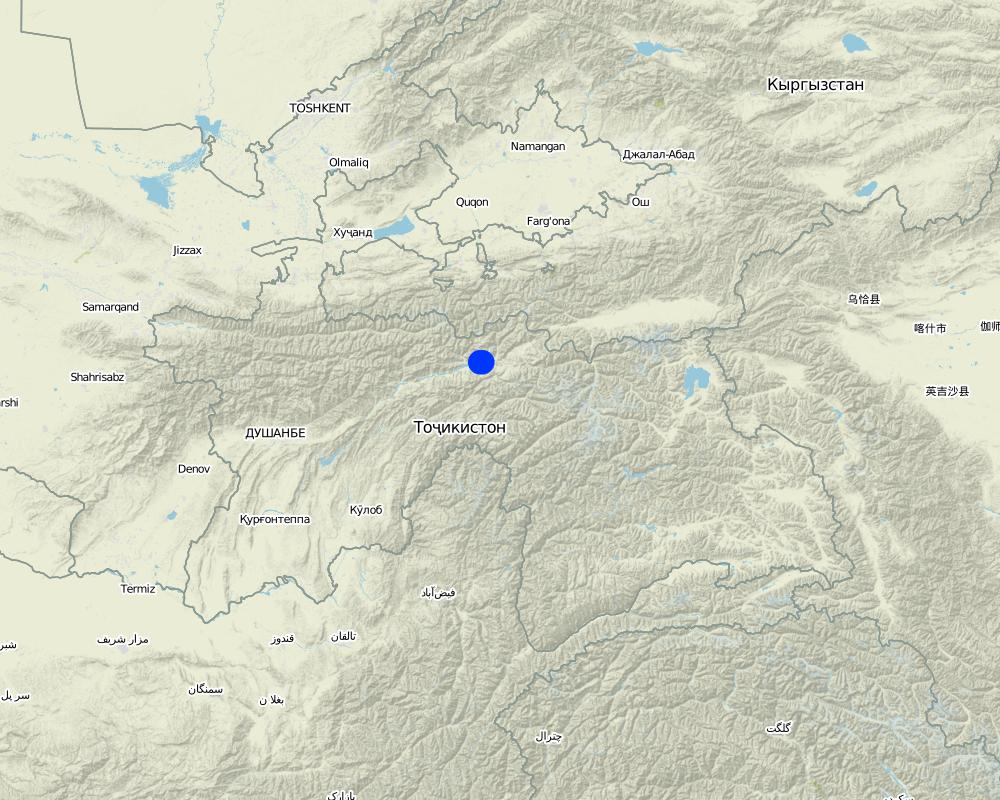Pasture and Livestock Management Plan [Tayikistán]
- Creación:
- Actualización:
- Compilador: Askarsho Zevarshoev
- Editor: –
- Revisores: Yacime Khadraoui, Maximilian Knoll
Накшаи Идоракунии Чорво ва Чарогох
approaches_3459 - Tayikistán
Visualizar secciones
Expandir todo Colapsar todos1. Información general
1.2 Detalles de contacto de las personas de referencia e instituciones involucradas en la evaluación y la documentación del Enfoque
Nombre del proyecto que facilitó la documentación/ evaluación del Enfoque (si fuera relevante)
Environmental Land Management and Rural Livelihoods (ELMAR)Nombre de la(s) institución(es) que facilitaron la documentación/ evaluación del Enfoque si fuera relevante)
Aga Khan Foundation (Aga Khan Foundation) - Suiza1.3 Condiciones referidas al uso de datos documentados mediante WOCAT
¿Cuándo se compilaron los datos (en el campo)?
15/07/2014
El compilador y la/s persona(s) de referencia claves aceptan las condiciones acerca del uso de los datos documentados mediante WOCAT :
Sí
1.4 Referencia/s al/los Cuestionario(s) de Tecnologías MST
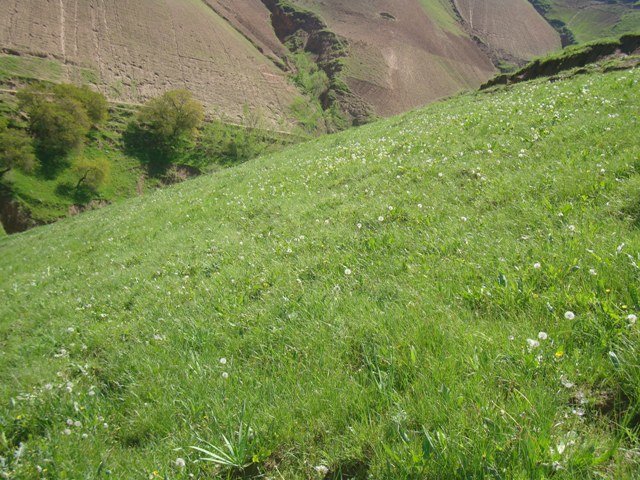
Rehabilitation of degraded pastures with alfalfa [Afganistán]
Degraded pastures are restored with alfalfa through broad seeding method. The area is put under quarantine for three years to allow for the pasture to restore sufficiently.
- Compilador: Bettina Wolfgramm
2. Descripción del Enfoque MST
2.1 Breve descripción del Enfoque
"Pasture and Livestock Management Plan" is a participatory approach which is guiding pasture users, members of Pasture User Unions and Pasture User Groups to develop their action plan on pasture and livestock management. The approach brings together stakeholders, who are involved at any stage in pasture management or can contribute to or impede the implementation of the pasture livestock management plan.
2.2 Descripción detallada del Enfoque MST
Descripción detallada del Enfoque MST:
Pasture and Livestock Management Plan (PLMP) Approach is a participatory approach towards the development of a pasture plan with communities to ensure a sustainable use of pasture resources. It was especially designed for the needs of the Pasture User Union, a new structure allowed to establish at community level to implement better management of their pasture resources. Though a step-by-step analysis of the current situation a community will come up with detailed action plan for the following three years. The PLMP involves, but is not limited to, the establishment of a committee involved in preparation of the PLMP, as well as a stakeholder analysis and the determination of the carrying capacity of pasture resources by comparing the existing fodder resources and requirements for the fodder. Based on that analysis, an action plan will be developed with involvement of all stakeholders to reach an agreement on approaches and technologies to implement the interventions. The PLMP will lead to the development of the Action Plan based on the discussion between different stakeholders. In the process of the plan development with consideration of an expert a clear roles and responsibilities of all involved actors/stakeholder in a defined timeframe will be identified.
The main objectives is to support land users with development of actions, which contribute to the sustainable development of pasture resource and livestock development. The central focus is given to balance the need of the livestock owners to improve livestock productivity with compromising the environmental conditions for the next generations and ecosystem services. The planning process should contribute to better management of pasture lands, rehabilitation of degraded pastures, resolving any existing conflict over pasture use, awareness raising on the role of pasture land for ecosystem services and overall trends in development with regards to use and management of pasture resources.
The process is based on participatory methods with involvement of different stakeholders capturing main principles for land use planning. The process includes pasture users/livestock owners who are involved in day to day management of pasture lands, local government with related department to pasture use, land owners, different departments of local government such as forestry, land use committee, environmental protection etc.
The approach is conducted in three main stages: In the firs stage consultation with pasture users will be held to identify the need for development of a pasture plan. Then an inventory of all land resources, including pasture land and livestock numbers will be conducted. In the third stage a workshop will be conducted with involvement of all stakeholders, where the pasture plan will be developed. In the final stage of the pasture plan development an action plan with defined clear activities in a given frame and assigned responsible persons will be developed.
Land users, who also own livestock appreciate their involvement in the pasture development planning. They also like when their voice is taken into consideration in making any decision with regards to the pasture use.
2.3 Fotos del Enfoque
Comentarios generales sobre las fotos:
Participants reflecting on the overall process of the PLMP approach with all steps involved starting with setting up objectives and principles, analysis of stakeholders up to development of action plan.
2.5 País/ región/ lugares donde el Enfoque fue aplicado
País:
Tayikistán
Región/ Estado/ Provincia:
Rasht Valley/Lakhsh District
Especifique más el lugar :
PUUs established in Rasht Valley under ELMARLP
Map
×2.6 Fechas de inicio y conclusión del Enfoque
Si no se conoce el año preciso, indique la fecha aproximada en la que se inició el Enfoque:
hace menos de 10 años (recientemente)
2.7 Tipo de Enfoque
- proyecto/ basado en un programa
2.8 Propósitos/ objetivos principales del Enfoque
The main objective is to support land users with the development of actions, that contribute to the sustainable development of pasture resource and livestock development. The central focus is to balance the need of the livestock owners to improve livestock productivity without compromising the environmental conditions for next generations and ecosystem services. The planning process should contribute to better management of pasture lands, rehabilitation of degraded pastures, resolving any existing conflicts over pasture use, raise awareness on the role of pasture land for ecosystem services and overall trends in development with regards to use and management of pasture resources.
2.9 Condiciones que facilitan o impiden la implementación de la/s Tecnología/s aplicadas bajo el Enfoque
normas y valores sociales/ culturales/ religiosos
- impiden
Communities are used to an ad hoc use of natural resources and therefore sometime not willing to structured planning processes in terms of use of pasture resources.
disponibilidad/ acceso a recursos y servicios financieros
- impiden
In the case that funding is not available from project side, it may hinder further implementation of the actions planned under the PLMP approach.
entorno institucional
- facilitan
The PLMP approach is specifically designed for the PUU, which are legally registered institutes under the governmental law. This enables the process to run continously.
colaboración/ coordinación de actores
- facilitan
Depending on the leadership of the institutional structure, if well managed, it can enable collaboration among different stakeholders
- impiden
The newly established PUUs do not have enough power to influence the institutes in which stakeholders who are not interested in the sustainable use of pasture resources work hinder the planning process.
marco de trabajo legal (tenencia de tierra, derechos de uso de tierra y agua)
- facilitan
mainly used by the PUUs, which are are functioning in the framework of state law
políticas
- facilitan
The plan is developed for the Pasture User Unions, which are legal structure responsible for pasture management at community level.
gobernanza de tierras (toma de decisiones, implementación y aplicación)
- facilitan
The approach will enable community members (PUUs) to become legal owners of the pasture resources according to the Pasture Law of the Republic of Tajikistan.
conocimiento de MST, acceso a apoyo técnico
- facilitan
Experts in the field are supported technically by project consultants, several trainings on the process and approach are conducted for them.
3. Participación y roles de las partes interesadas involucradas
3.1 Partes interesadas involucradas en el Enfoque y sus roles
- usuarios locales de tierras/ comunidades locales
livestock owners and PUU members
involved in direct process development and implementation of the approach
- organizaciones comunitarias
village organizations, pasture user unions
also registered in the framework of the state law and are represented in the PUU. mainly involved in mobilization of the community to participate in the development and implementation of the plan
- especialistas MST/consejeros agrícolas
project consultants and technical staff
facilitate the process of developing the PLMP approach, capacity building on the approach for the members of PUU
- ONG
locally registered public organizations which are directly involved in the natural resource and environmental management
provide technical support to the community and land users; can also support with fundraising
- sector privado
entrepreneurs at local level
co-funding of the implementation of some of the practices from the PLMP
- gobierno local
local level government (sub-district authority), land use committee, committee of environmental protection, agriculture department etc.,
as one of the main stakeholders responsible for management of natural resource; can also provide overall supervision of the approach development; PUUs for which the PLMP is developed: legal structure under the Pasture Law of the Republic of Tajikistan.
Si varias partes interesadas estuvieron involucradas, indique la agencia principal:
Land Commttee
3.2 Involucramiento de los usuarios locales de tierras/ comunidades locales en las distintas fases del Enfoque
| Involucramiento de los usuarios locales de tierras/ comunidades locales | Especifique quién se involucró y describa las actividades | |
|---|---|---|
| iniciación/ motivación | apoyo externo | livestock owners, PUU members; consultation with livestock owners, facilitation the process of establishment of PUUs |
| planificación | interactivo | land users, PUU members, pasture experts |
| implementación | interactivo | PUU members and expert from project; consultation with stakeholders, conduct workshop and development of the plan |
| monitoreo y evaluación | apoyo externo | from project team and management of PUU |
3.4 La toma de decisiones en la selección de Tecnología(s) MST
Especifique quién decidió la selección de las Tecnología/ Tecnologías a implementarse:
- principalmente por especialistas MST en consulta con usuarios de tierras
Explique:
Mainly as a new approach, best practices from the WOCAT database were used by the SLM specialists to introduce to land users and traditional practices were also applied based on the knowledge of land users.
Especifique las bases que sustentaron la toma de decisiones:
- la evaluación de conocimiento MST bien documentado (la toma de decisiones se basa en evidencia)
- la experiencia personal y opiniones (no documentadas)
4. Apoyo técnico, fortalecimiento institucional y gestión del conocimiento
4.1 Construcción de capacidades / capacitación
¿Se proporcionó la capacitación a usuarios de tierras/ otras partes interesadas?
Sí
Especifique quién fue capacitado:
- usuarios de tierras
- personal de campo/ consejeros
Forma de capacitación:
- en el contexto de trabajo
- reuniones públicas
Temas avanzados:
"Pasture and Livestock Management Plan" methodology, proposal development for fund raising, Environmental Land Management
4.2 Servicio de asesoría
¿Los usuarios de tierras tienen acceso a un servicio de asesoría?
Sí
Especifique si servicio proporcionado se realizó:
- en los campos de los usuarios de tierras
Describa/ comentarios:
During the project period continuos visits were organized to the project site to review the progress and provide advisory service. The project implmentation team consisting of different experts, including pasture, environmental specialists and monitoring and evaluation experts.
4.3 Fortalecimiento institucional (desarrollo institucional)
¿Se establecieron o fortalecieron instituciones mediante el Enfoque?
- sí, mucho
Especifique el nivel o los niveles en los que se fortalecieron o establecieron las instituciones:
- local
Describa la institución, roles y responsabilidades, miembros, etc.
Pasture User Union was established at sub-district level.
Especifique el tipo de apoyo:
- financiero
- construcción de capacidades/ entrenamiento
Proporcione detalles adicionales:
Different technical and administrative trainings were provided and the PUU was funded with certain amount for implementation of the PLMP approach.
4.4 Monitoreo y evaluación
¿El monitoreo y la evaluación forman parte del Enfoque?
Sí
Comentarios:
The final section of the PLMP is monitoring and evaluation. At each stage a responsible person among the stakeholders is assigned to conduct the plan implementation. In addition, the project team also conducts monitoring of the approach.
Si respondió que sí, ¿la documentación se utilizará para monitoreo y evaluación?
Sí
Comentarios:
The implementing agency has a monitoring methodology, which will be used by the project team to conduct monitoring.
4.5 Investigación
¿La investigación formó parte del Enfoque?
No
5. Financiamiento y apoyo material externo
5.1 Presupuesto anual para el componente MST del Enfoque
Si no se conoce el presupuesto anual preciso, indique el rango:
- 2,000-10,000
Comentarios (ej. fuentes principales de financiamiento/ donantes principales):
World Bank in the framework of ELMARL - Environmental Land Management and Rural Livelihood project
5.2 Apoyo financiero/material proporcionado a los usuarios de tierras
¿Los usuarios de tierras recibieron financiamiento/ apoyo material para implementar la Tecnología/ Tecnologías? :
No
5.3 Subsidios para insumos específicos (incluyendo mano de obra)
- ninguno
Si la mano de obra de usuarios de tierras fue un insumo sustancial, ¿fue:
- voluntario?
Comentarios:
This is traditional now and any project fund should be accompanied by contributions from communities, which is mainly labour on a voluntary basis
5.4 Crédito
¿Se proporcionó crédito bajo el Enfoque para actividades MST?
No
5.5 Otros incentivos o instrumentos
¿Se usaron otros incentivos o instrumentos para promover la implementación de Tecnologías MST?
No
6. Análisis de impacto y comentarios de conclusión
6.1 Impactos del Enfoque
¿El Enfoque empoderó a los usuarios locales de tierras, mejoró el involucramiento de las partes interesadas?
- No
- Sí, un poco
- Sí, moderadamente
- Sí, mucho
It directly helped them to identify their status and understand their right to land use.
¿El Enfoque ayudó a los usuarios de tierras a implementar y mantener Tecnologías MST?
- No
- Sí, un poco
- Sí, moderadamente
- Sí, mucho
All technologies planned under the approach as part of their action plan were later financed by projects to implement.
after development of the pasture and livestock management plan the PUUs were supported financial from the ELMARL project to implement the plan
the plan is developed through conducted workshop with participation of all stakeholders, including land users, where they get opportunity to learn experiences of other stakeholders.
All stakeholders involved in the process including women and youth had an opportunity to make decisions in line with other stakeholders.
¿El Enfoque mitigó conflictos?
- No
- Sí, un poco
- Sí, moderadamente
- Sí, mucho
Roles and responsibilities identified all stakeholder and one of the objective to mitigate conflict brought under discussion conflict over pasture use and tried to solve it to some extent.
¿El Enfoque empoderó a grupos en desventaja social y económica?
- No
- Sí, un poco
- Sí, moderadamente
- Sí, mucho
Women's role in livestock management was identified and empowered.
All stakeholders involved in the process including women and youth had an opportunity to make decisions in line with other stakeholders.
the approach give the land users/PUU members rights to become owner of the pasture under the Pasture Law of the Republic of Tajikistan
6.2 Motivación principal del usuario de la tierra para implementar MST
- producción incrementada
- reducción de la degradación de la tierra
The rotation plan for rehabilitation of degraded pasture is applied.
- reducción del riesgo de desastres naturales
Watershed approach was applied to ban grazing in some areas to prevent land slide and mudflow as a result of degradation.
- reglas y reglamentos (multas)/ aplicación
The plan does not set certain rules at this stage to enforce the regulation, but the community is planning to negotiate and set certain rules in case of not following the regulations to implement the plan.
6.3 Sostenibilidad de las actividades del Enfoque
¿Pueden los usuarios de tierras sostener lo que se implementó mediante el Enfoque (sin apoyo externo)?
- incierto
Si respondió no o incierto, especifique y comente:
depends on the availability of funding, leadership and support from other stakeholders, especially local government
6.4 Fortalezas/ ventajas del Enfoque
| Fuerzas/ ventajas/ oportunidades desde la perspectiva del usuario de la tierra |
|---|
| active participation in the development of the plan |
| better understanding of the current situation with regards to pasture use and importance of pasture plan development |
| Fuerzas/ ventajas/ oportunidades desde la perspectiva del compilador o de otra persona de referencia clave |
|---|
| involvement of all stakeholders, especially land users and taking their knowledge and voice into consideration in decision making |
| building of the knowledge and opening a platform for collaboration between different stakeholders interested in sustainable management of pasture resources |
6.5 Debilidades/ desventajas del Enfoque y formas de sobreponerse a ellos
| Debilidades/ desventajas/ riesgos desde la perspectiva del usuario de la tierra | ¿Cómo sobreponerse a ellas? |
|---|---|
| time consuming, requires resource in the short term | should be understand as a means of livelihoods and spend more time, improve understanding of better gain in a long term |
| Debilidades/ desventajas/ riesgos desde la perspectiva del compilador o de otra persona de referencia clave | ¿Cómo sobreponerse a ellas? |
|---|---|
| financial resources | should design longer term project to attract funding before the approach becomes self sustained |
| low capacity of the stakeholders, | more trainings, sharing of experiences |
| human resources | More focus should be given to younger generation to build their capacity and involve them in the approach development |
7. Referencias y vínculos
7.1 Métodos/ fuentes de información
- visitas de campo, encuestas de campo
6
- entrevistas con usuarios de tierras
more than 50
- entrevistas con especialistas/ expertos en MST
5
- compilación de informes y otra documentación existente
3
7.2 Referencias a publicaciones disponibles
Título, autor, año, ISBN:
Pasture and Livestock Management Plan Manual
¿Dónde se halla disponible? ¿Costo?
Available upon request
7.3 Vínculos a la información relevante disponible en línea
Título/ descripción:
Pasture Management Networking Platform (PMNP)
URL:
https://pasture.klink.asia/dms/documents/groups/796?page=2
Vínculos y módulos
Expandir todo Colapsar todosVínculos

Rehabilitation of degraded pastures with alfalfa [Afganistán]
Degraded pastures are restored with alfalfa through broad seeding method. The area is put under quarantine for three years to allow for the pasture to restore sufficiently.
- Compilador: Bettina Wolfgramm
Módulos
No se hallaron módulos


